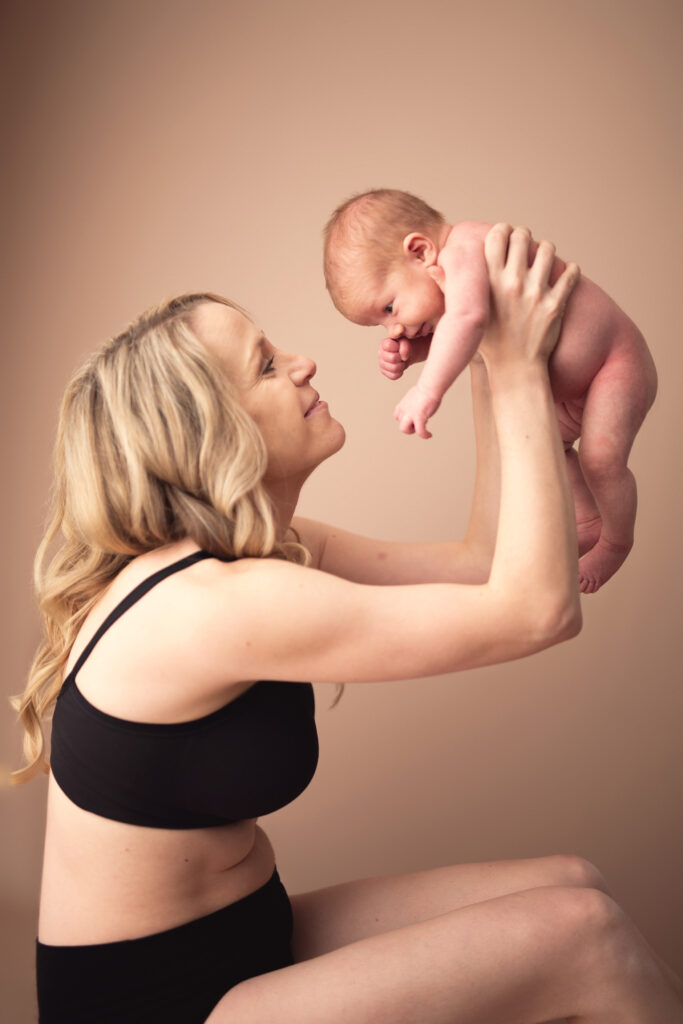Q&A with Pelvic Floor Physiotherapist, Jessica Doig, BScKin, MScPT.
If you haven’t yet met Jess (or seen her relatable, engaging, and insightful content on Instagram) I strongly encourage you to seek her out! Jess is a wealth of knowledge on optimizing your pelvic floor health and shares it generously with her audience.
Although I hadn’t met her soon enough after my own babies were born, I did have the pleasure of working with Jess on both her maternity and newborn photo sessions. Both with a bit of a twist and a creative deviation from my usual offerings (check out the images in this blog post to see what I mean).
With so many new moms and moms-to-be visiting my blog, I thought I’d glean some of Jess’ knowledge on this topic and share it here with you. I asked Jess a few typical questions that many expectant and new moms often have when on this journey.
Now… I’ll also admit that when I was pregnant, I didn’t even know to ask these questions. Optimizing my pelvic floor health was far from my mind. None of this was ever mentioned to me at any pre-natal or postpartum visits with my doctors. This, to me, is evidence to the fact that our healthcare system often underserves women and young mothers. I wish I had this information earlier and I hope you find it a useful resource and jumping off point in your own motherhood journey.
So without further ado, let’s jump into the Q&A.



Pre-Pregnancy Preparation of Your Pelvic Floor
How can I prepare my pelvic floor muscles before getting pregnant to minimize issues during and after pregnancy?
It can be helpful to get to know your body prior to pregnancy. Learning how to connect to your core and pelvic floor properly prior to pregnancy can help your body adapt and respond to all of the physical and physiological changes that come with being pregnant. Having a pelvic floor assessment prior to pregnancy also allows you to get a baseline of how your muscles are functioning and address any issues that may negatively impact your pregnancy or birth experience.
Exercise During Pregnancy for Optimal Pelvic Floor Health
What types of pelvic floor exercises are safe and beneficial during pregnancy, and how often should I perform them?
There are actually no “safe” or “unsafe” exercises for pregnant women, including exercises specific to the pelvic floor (unless you have a contra-indication to specific exercises due to high risk pregnancy or complications). In fact, it’s HOW you perform an exercise that’s important and whether or not you have symptoms during that activity. It is however important to understand what your pelvic floor and core muscles are doing and how to utilize them throughout your pregnancy and exercise routine. I also highly encourage all pregnant women to check in with a pelvic floor physiotherapist to have their pelvic floor and core muscles assessed throughout their pregnancy and have specific and individualized exercise programs.
It’s important to note that KEGELS are not always appropriate for pregnant women and more often than not, when it comes to birth preparation, knowing how to relax their pelvic floors becomes the most useful and impactful exercise they can do.
Labor and Delivery Concerns
Are there specific techniques or exercises that can help me during labor and delivery to support my pelvic floor?
Absolutely! We can utilize different movements and positions during labor to help encourage your baby to descend through the pelvis. For example in the beginning stages of labor when baby is at the top of the pelvis, wider knees (deep squat) positions and anterior/posterior pelvic rocks can help encourage baby to descend, however, when you are ready to push, we actually want the opposite position (ankles wider than knees) to open up the bottom of the pelvis. Your pelvic floor physiotherapist will also teach you breathing and relaxation strategies, pushing techniques, perineal stretching and mobility exercises to help
decrease pain and trauma to the pelvic floor during birth and to help decrease your risk of severe perineal tearing.



Postpartum Recovery
What can I do to promote optimal pelvic floor recovery in the immediate postpartum period?
The most important thing to remember after giving birth is….. that you just gave birth! Meaning, making sure you give yourself time to recover. Childbirth is traumatic on the body (regardless of how you delivered; vaginally or via c-section) and you deserve adequate time to rest and recover (while also taking care of this whole new person).
It’s important to limit pressure on your pelvic floor and core during the immediate postpartum period to allow for your tissues and muscles to recover. How do you limit pressure? By using your breath. Exhale as you move. Exhale as you lift and exhale as you poop. I always tell my clients, exhaling is like opening a can of pop, all the pressure comes out the top. Meaning when you’re doing a task that increases intra-abdominal pressure (and therefore pressure on your pelvic floor) like lifting your baby, getting up off the couch or having a bowel movement, then remember to exhale. Depending on how your birth experience went, doing some gentle core and pelvic floor activation exercises can also be helpful.
C-Section Recovery
If I have a C-section, how does that affect my pelvic floor, and what exercises or precautions should I take during recovery?
There is a misconception that having a cesarean section “protects” you from pelvic floor issues. Unfortunately, the main risk factor for pelvic floor dysfunction is pregnancy itself, regardless of mode of delivery. However, C-sections are major abdominal surgeries and recovery can be slower. You will have an abdominal incision to protect and in the first two weeks after surgery even the simplest movements like rolling in bed or getting up out of a chair can be quite uncomfortable.
Splinting your incision (gentle pressure over your incision using a hand or pillow) during these movements and when laughing, coughing or sneezing, can ease pressure and tension on your scar and make movement a little easier. Typically after the first 1-2 weeks you are moving and feeling much better. Monitor your incision for signs of infection (increased redness, pain or discharge) in the first days and weeks after your surgery.
After your incision is fully healed, and you are cleared by your healthcare provider then performing scar massage can help improve your scar’s mobility and appearance and has also been shown to help with urinary and pelvic pain symptoms.
Returning to Exercise Postpartum
When is it safe to resume regular exercise, including activities like running or weightlifting, after giving birth?
This is a loaded question and the answer will always be “It depends”. It depends on many factors such as your choice of exercise, if you were exercising prior to and during pregnancy, how your birth experience went, what kinds of support you have at home, if you are having pelvic floor or other musculoskeletal symptoms etc etc etc.
Generally speaking however, I encourage moms to begin core and pelvic floor rehab within 4-6 weeks after birth, followed by progressive resistance training and then lastly after a few weeks to months of consistent strength training to add in higher impact exercise like running. Strength training is extremely important and valuable when it comes to injury prevention and really should be included in all postpartum rehab programs. I would also encourage moms to work with a physiotherapist or coach that has specialized education and training in pregnancy and postpartum exercise.
Diastasis Recti
How does diastasis recti relate to pelvic floor health, and what exercises can help address both issues?
Diastasis Recti (DRA) is the term used to describe the abdominal separation that occurs during pregnancy and that can persist postpartum. The connective tissue that holds your rectus abdominis muscles (also known as your six-pack muscles) together (called your linea alba) stretches and thins during pregnancy, to allow your belly to expand and to accommodate your growing baby.
Research shows that DRA occurs in 100% of pregnancies by 35 weeks. In roughly 40% of women diastasis recti can persist and require intentional core rehab and strengthening to recover. Signs of Diastasis Recti in pregnancy are typically a bulging or tenting that occurs in the center of the abdomen, usually seen with a head lift or crunch type motion or plank exercise. Learning how to engage your core properly can help decrease pressure on your diastasis during pregnancy and encourage the abdominal muscles to recover faster after birth.
Incontinence Concerns
If I’m experiencing urinary incontinence postpartum, what strategies or exercises can help improve bladder control?
Urinary incontinence or bladder leakage occurs in up to 44 % of women after birth, with 92% of women who experience incontinence at 12 weeks postpartum continuing to experience the issue 5 years later. Although postpartum bladder leakage is common, it is NOT normal
and The Society of Obstetricians and Gynecolgists of Canada (SOGC) recommends pelvic floor physiotherapy be offered to every person experiencing urinary incontinence.
Bladder leakage can occur for many different reasons and unfortunately giving general “kegel” exercises to every postpartum person has shown to be unhelpful and may even cause some symptoms to worsen. Instead, I recommend seeing a pelvic floor physiotherapist to assess the underlying cause of the leakage and have an exercise program based on your individual needs.
Long-Term Pelvic Floor Health
What long-term considerations should I keep in mind for maintaining optimal pelvic floor health as I age and potentially have more children?
There is a common misconception that you should wait to address any of your pelvic floor concerns until after you are done having children. However, that strategy is likely going to make your pelvic floor symptoms worse, and each subsequent pregnancy less enjoyable. If you properly rehab your pelvic floor and core after birth, you can prevent injury, decrease the risk of pelvic floor and other musculoskeletal issues during subsequent pregnancies and even improve each postpartum recovery experience .
Being intentional about your pelvic floor health is important throughout every stage of life. The risk of pelvic floor dysfunction increases as we age and as our hormones shift through menopause and beyond. Having a good understanding of how to engage your core and pelvic floor can prevent issues from developing later in life.
Learn More About How To Optimize Your Pelvic Floor Health
I’m grateful to Jess for taking the time to answer these questions and sharing her insights on optimizing pelvic floor heath. Whether you’re just thinking about having a baby, are currently pregnant, or (like me) all your babies are now school age, I hope you’ve found this helpful. Let me know in the comments if you have any other questions that haven’t been addressed here. I update content regularly and will add your questions and Jess’ answers, as needed.
The above Q&A only begins to scratch the surface of this topic. To learn more about how to optimize your pelvic floor health, before, during, and after pregnancy, visit the Collingwood Pelvic Health website and dig into their “Resources” section for more information. You can also book an appointment right on the website, which is super convenient!
Looking for more helpful blog posts related to all things motherhood in Collingwood, Ontario? Check out my other blog posts! Loved the images from Jess’ sessions and want to chat about scheduling yours? Reach out to me here and we’ll chat about session options.

leave a comment